BAP61 Stakeholder Values: Analyzing TAP Pharmaceuticals Ethics
VerifiedAdded on 2023/06/04
|5
|919
|334
Case Study
AI Summary
This case study delves into the unethical culture prevalent at TAP Pharmaceuticals, highlighting the misalignment of its systems with ethical conduct. It examines how the company prioritized sales over legal compliance, resorting to practices such as bribing doctors and mismanaging drug samples. The case further evaluates Douglas Durand's unsuccessful attempts to foster a more ethical environment within TAP. Despite his efforts to reinforce ethical conduct and introduce reward systems for compliance, Durand faced resistance from senior management, ultimately leading to the failure of his initiatives. The analysis reveals a corporate environment where ethical considerations were secondary to profit, and where attempts to instigate change were stifled by a deeply ingrained culture of misconduct.
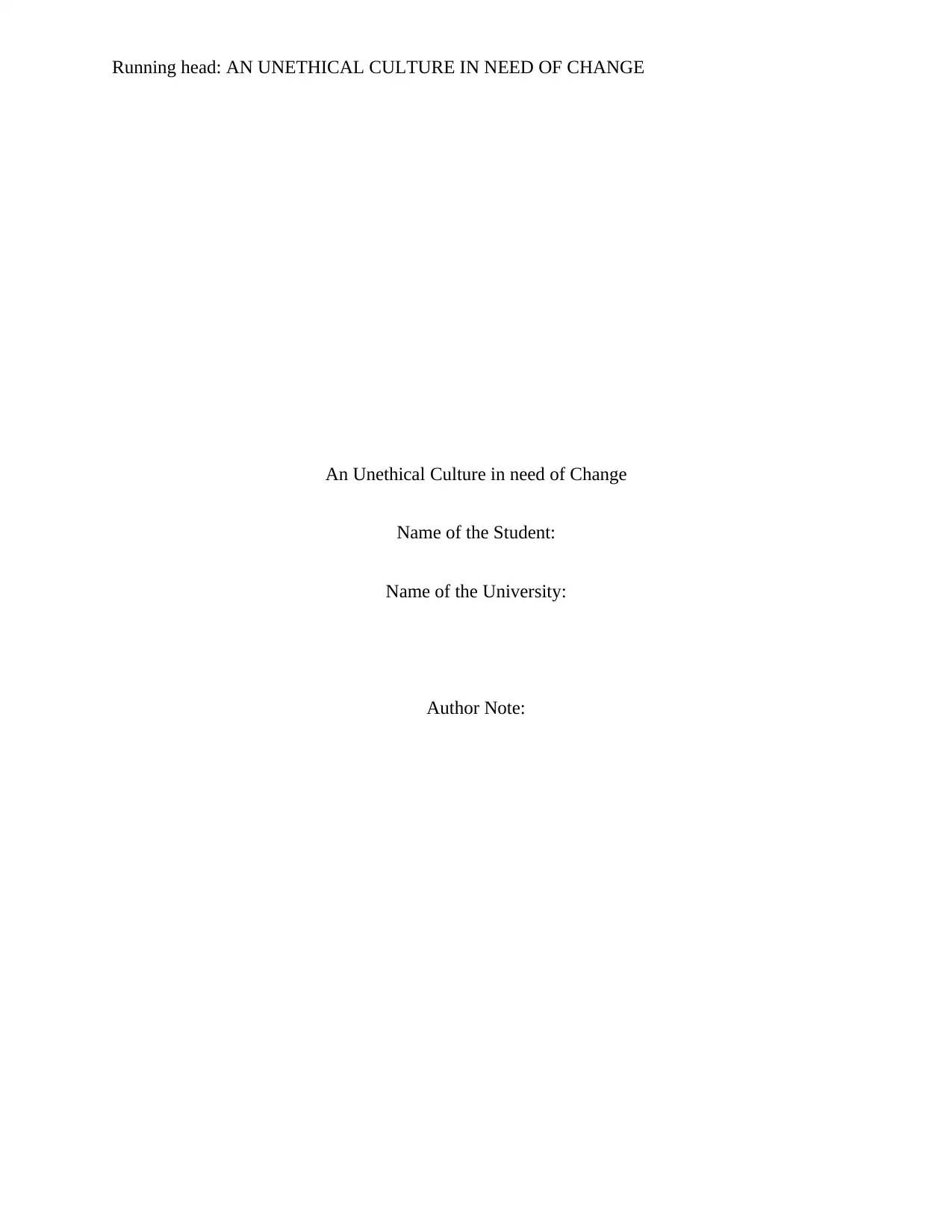
Running head: AN UNETHICAL CULTURE IN NEED OF CHANGE
An Unethical Culture in need of Change
Name of the Student:
Name of the University:
Author Note:
An Unethical Culture in need of Change
Name of the Student:
Name of the University:
Author Note:
Paraphrase This Document
Need a fresh take? Get an instant paraphrase of this document with our AI Paraphraser
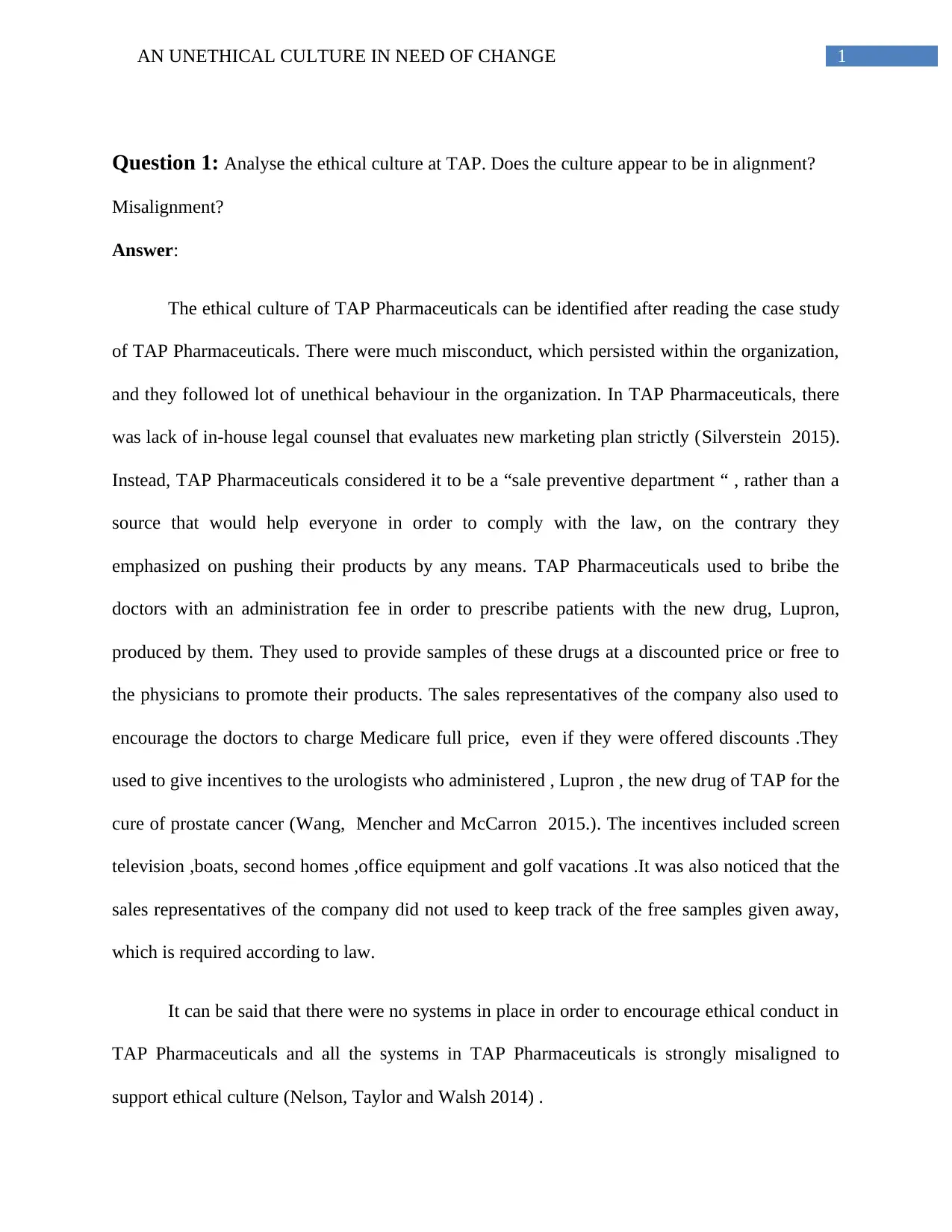
1AN UNETHICAL CULTURE IN NEED OF CHANGE
Question 1: Analyse the ethical culture at TAP. Does the culture appear to be in alignment?
Misalignment?
Answer:
The ethical culture of TAP Pharmaceuticals can be identified after reading the case study
of TAP Pharmaceuticals. There were much misconduct, which persisted within the organization,
and they followed lot of unethical behaviour in the organization. In TAP Pharmaceuticals, there
was lack of in-house legal counsel that evaluates new marketing plan strictly (Silverstein 2015).
Instead, TAP Pharmaceuticals considered it to be a “sale preventive department “ , rather than a
source that would help everyone in order to comply with the law, on the contrary they
emphasized on pushing their products by any means. TAP Pharmaceuticals used to bribe the
doctors with an administration fee in order to prescribe patients with the new drug, Lupron,
produced by them. They used to provide samples of these drugs at a discounted price or free to
the physicians to promote their products. The sales representatives of the company also used to
encourage the doctors to charge Medicare full price, even if they were offered discounts .They
used to give incentives to the urologists who administered , Lupron , the new drug of TAP for the
cure of prostate cancer (Wang, Mencher and McCarron 2015.). The incentives included screen
television ,boats, second homes ,office equipment and golf vacations .It was also noticed that the
sales representatives of the company did not used to keep track of the free samples given away,
which is required according to law.
It can be said that there were no systems in place in order to encourage ethical conduct in
TAP Pharmaceuticals and all the systems in TAP Pharmaceuticals is strongly misaligned to
support ethical culture (Nelson, Taylor and Walsh 2014) .
Question 1: Analyse the ethical culture at TAP. Does the culture appear to be in alignment?
Misalignment?
Answer:
The ethical culture of TAP Pharmaceuticals can be identified after reading the case study
of TAP Pharmaceuticals. There were much misconduct, which persisted within the organization,
and they followed lot of unethical behaviour in the organization. In TAP Pharmaceuticals, there
was lack of in-house legal counsel that evaluates new marketing plan strictly (Silverstein 2015).
Instead, TAP Pharmaceuticals considered it to be a “sale preventive department “ , rather than a
source that would help everyone in order to comply with the law, on the contrary they
emphasized on pushing their products by any means. TAP Pharmaceuticals used to bribe the
doctors with an administration fee in order to prescribe patients with the new drug, Lupron,
produced by them. They used to provide samples of these drugs at a discounted price or free to
the physicians to promote their products. The sales representatives of the company also used to
encourage the doctors to charge Medicare full price, even if they were offered discounts .They
used to give incentives to the urologists who administered , Lupron , the new drug of TAP for the
cure of prostate cancer (Wang, Mencher and McCarron 2015.). The incentives included screen
television ,boats, second homes ,office equipment and golf vacations .It was also noticed that the
sales representatives of the company did not used to keep track of the free samples given away,
which is required according to law.
It can be said that there were no systems in place in order to encourage ethical conduct in
TAP Pharmaceuticals and all the systems in TAP Pharmaceuticals is strongly misaligned to
support ethical culture (Nelson, Taylor and Walsh 2014) .
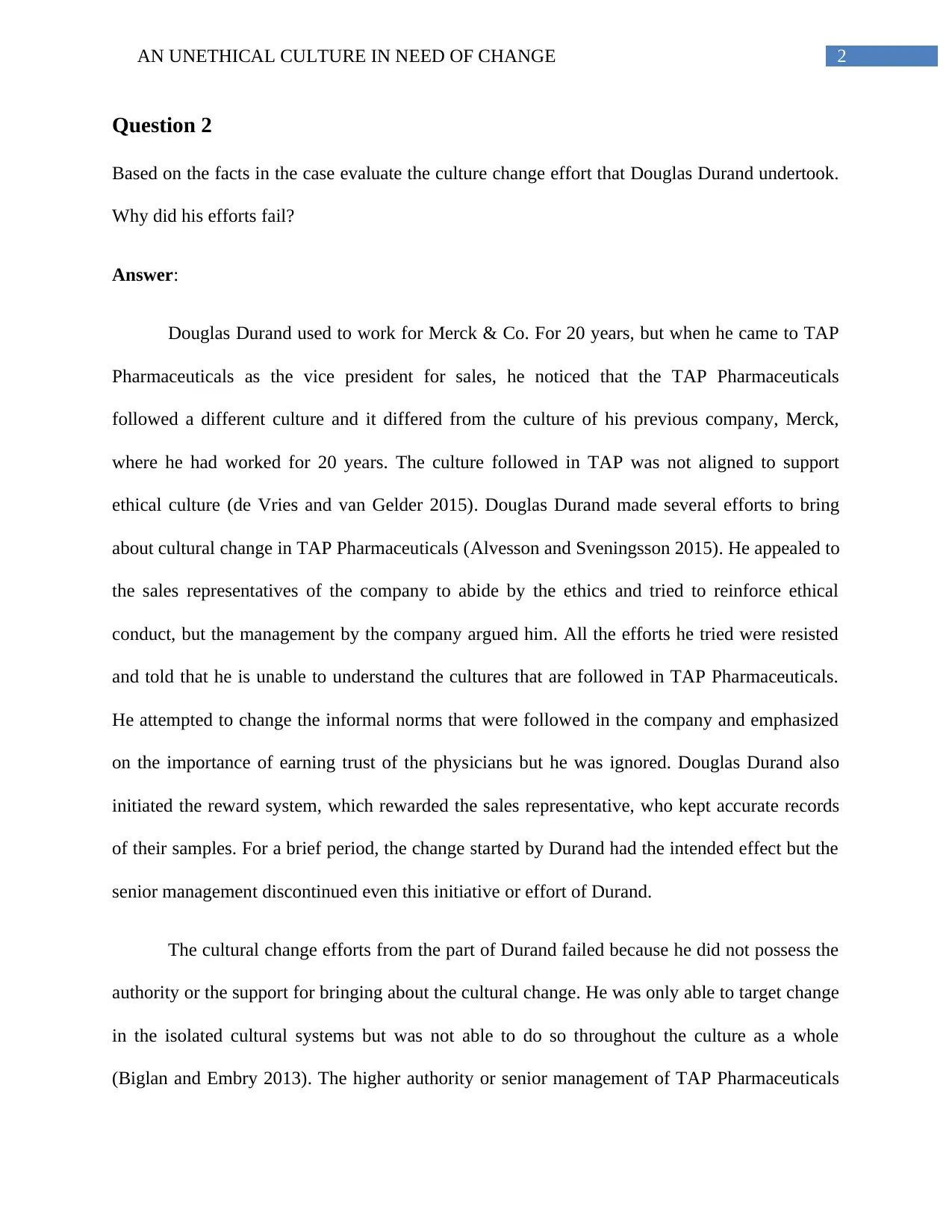
2AN UNETHICAL CULTURE IN NEED OF CHANGE
Question 2
Based on the facts in the case evaluate the culture change effort that Douglas Durand undertook.
Why did his efforts fail?
Answer:
Douglas Durand used to work for Merck & Co. For 20 years, but when he came to TAP
Pharmaceuticals as the vice president for sales, he noticed that the TAP Pharmaceuticals
followed a different culture and it differed from the culture of his previous company, Merck,
where he had worked for 20 years. The culture followed in TAP was not aligned to support
ethical culture (de Vries and van Gelder 2015). Douglas Durand made several efforts to bring
about cultural change in TAP Pharmaceuticals (Alvesson and Sveningsson 2015). He appealed to
the sales representatives of the company to abide by the ethics and tried to reinforce ethical
conduct, but the management by the company argued him. All the efforts he tried were resisted
and told that he is unable to understand the cultures that are followed in TAP Pharmaceuticals.
He attempted to change the informal norms that were followed in the company and emphasized
on the importance of earning trust of the physicians but he was ignored. Douglas Durand also
initiated the reward system, which rewarded the sales representative, who kept accurate records
of their samples. For a brief period, the change started by Durand had the intended effect but the
senior management discontinued even this initiative or effort of Durand.
The cultural change efforts from the part of Durand failed because he did not possess the
authority or the support for bringing about the cultural change. He was only able to target change
in the isolated cultural systems but was not able to do so throughout the culture as a whole
(Biglan and Embry 2013). The higher authority or senior management of TAP Pharmaceuticals
Question 2
Based on the facts in the case evaluate the culture change effort that Douglas Durand undertook.
Why did his efforts fail?
Answer:
Douglas Durand used to work for Merck & Co. For 20 years, but when he came to TAP
Pharmaceuticals as the vice president for sales, he noticed that the TAP Pharmaceuticals
followed a different culture and it differed from the culture of his previous company, Merck,
where he had worked for 20 years. The culture followed in TAP was not aligned to support
ethical culture (de Vries and van Gelder 2015). Douglas Durand made several efforts to bring
about cultural change in TAP Pharmaceuticals (Alvesson and Sveningsson 2015). He appealed to
the sales representatives of the company to abide by the ethics and tried to reinforce ethical
conduct, but the management by the company argued him. All the efforts he tried were resisted
and told that he is unable to understand the cultures that are followed in TAP Pharmaceuticals.
He attempted to change the informal norms that were followed in the company and emphasized
on the importance of earning trust of the physicians but he was ignored. Douglas Durand also
initiated the reward system, which rewarded the sales representative, who kept accurate records
of their samples. For a brief period, the change started by Durand had the intended effect but the
senior management discontinued even this initiative or effort of Durand.
The cultural change efforts from the part of Durand failed because he did not possess the
authority or the support for bringing about the cultural change. He was only able to target change
in the isolated cultural systems but was not able to do so throughout the culture as a whole
(Biglan and Embry 2013). The higher authority or senior management of TAP Pharmaceuticals
⊘ This is a preview!⊘
Do you want full access?
Subscribe today to unlock all pages.

Trusted by 1+ million students worldwide
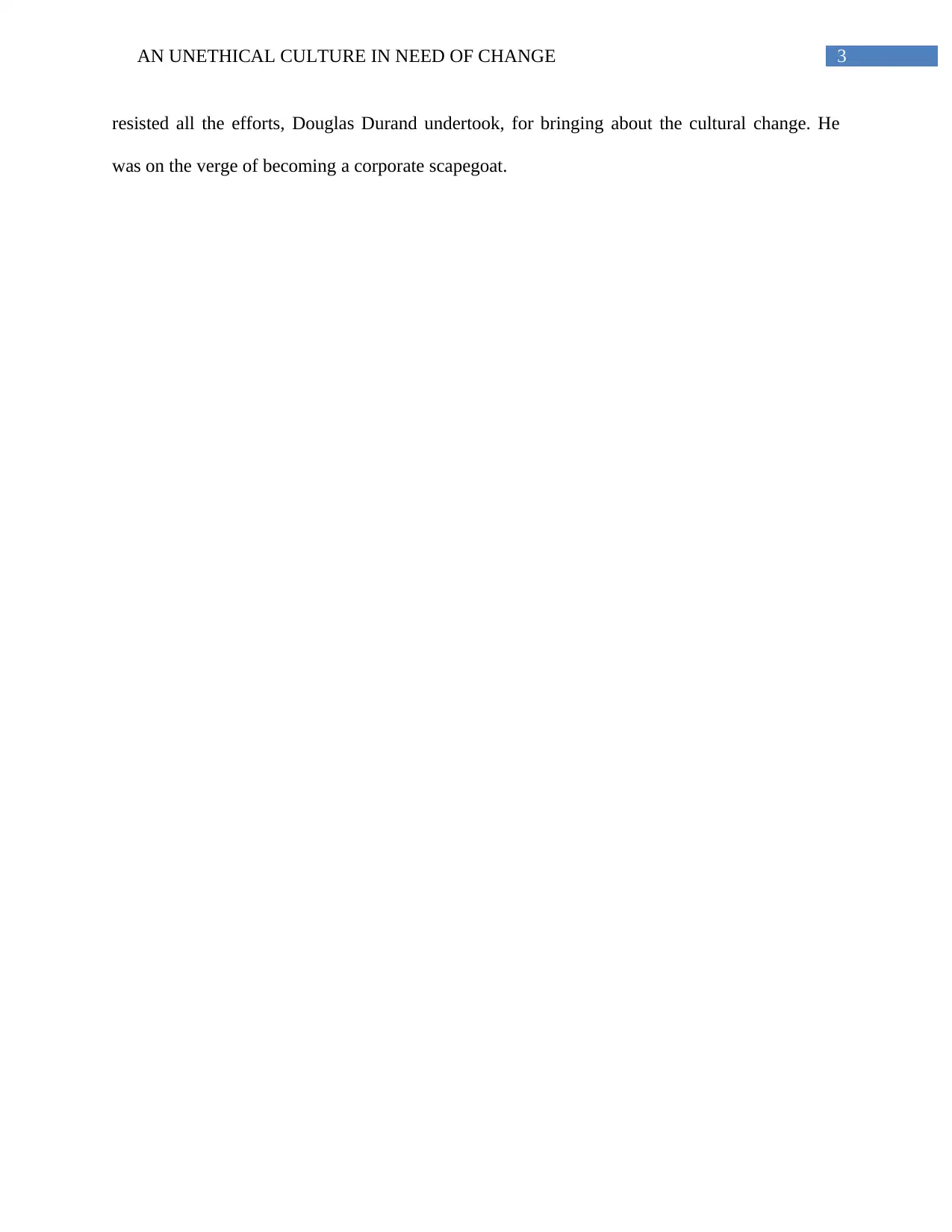
3AN UNETHICAL CULTURE IN NEED OF CHANGE
resisted all the efforts, Douglas Durand undertook, for bringing about the cultural change. He
was on the verge of becoming a corporate scapegoat.
resisted all the efforts, Douglas Durand undertook, for bringing about the cultural change. He
was on the verge of becoming a corporate scapegoat.
Paraphrase This Document
Need a fresh take? Get an instant paraphrase of this document with our AI Paraphraser
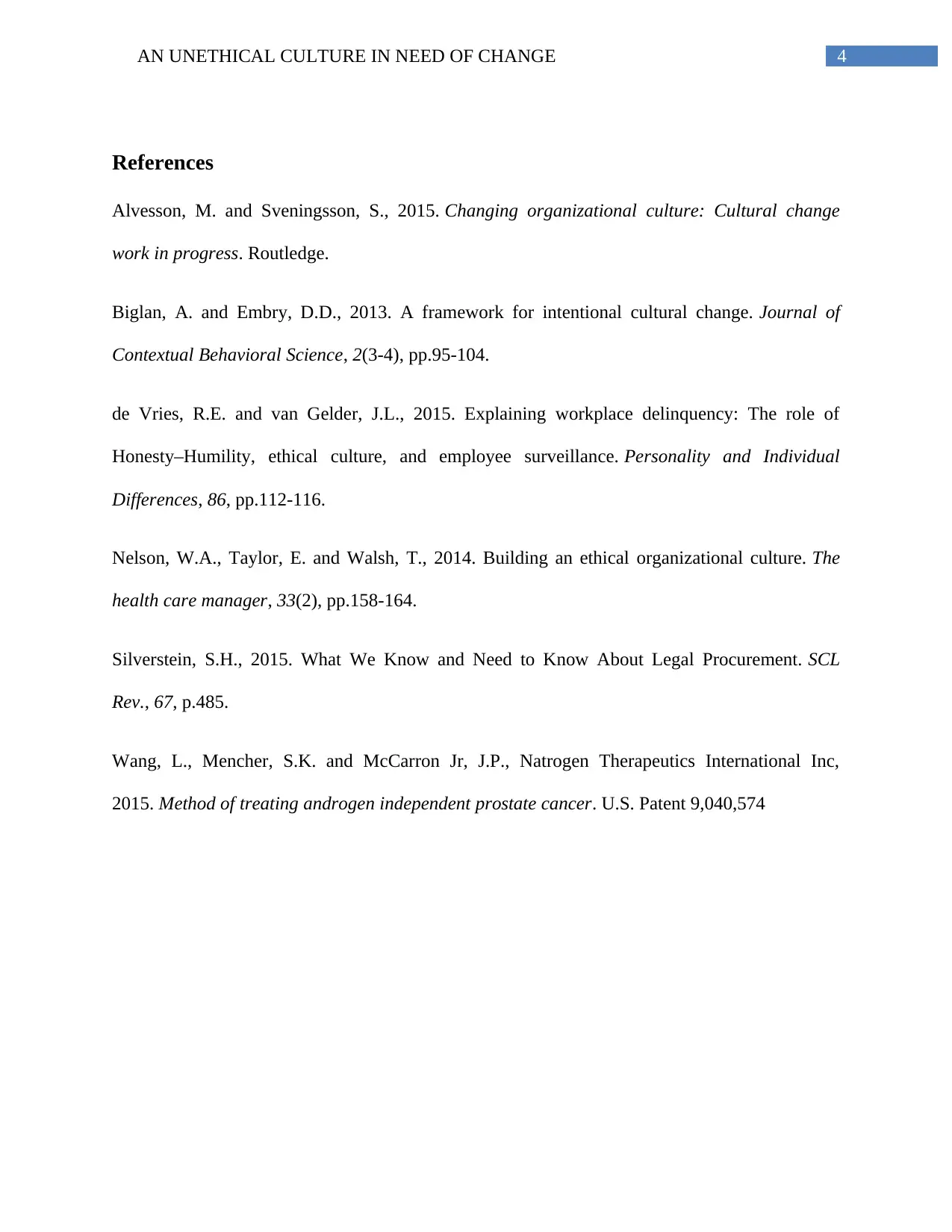
4AN UNETHICAL CULTURE IN NEED OF CHANGE
References
Alvesson, M. and Sveningsson, S., 2015. Changing organizational culture: Cultural change
work in progress. Routledge.
Biglan, A. and Embry, D.D., 2013. A framework for intentional cultural change. Journal of
Contextual Behavioral Science, 2(3-4), pp.95-104.
de Vries, R.E. and van Gelder, J.L., 2015. Explaining workplace delinquency: The role of
Honesty–Humility, ethical culture, and employee surveillance. Personality and Individual
Differences, 86, pp.112-116.
Nelson, W.A., Taylor, E. and Walsh, T., 2014. Building an ethical organizational culture. The
health care manager, 33(2), pp.158-164.
Silverstein, S.H., 2015. What We Know and Need to Know About Legal Procurement. SCL
Rev., 67, p.485.
Wang, L., Mencher, S.K. and McCarron Jr, J.P., Natrogen Therapeutics International Inc,
2015. Method of treating androgen independent prostate cancer. U.S. Patent 9,040,574
References
Alvesson, M. and Sveningsson, S., 2015. Changing organizational culture: Cultural change
work in progress. Routledge.
Biglan, A. and Embry, D.D., 2013. A framework for intentional cultural change. Journal of
Contextual Behavioral Science, 2(3-4), pp.95-104.
de Vries, R.E. and van Gelder, J.L., 2015. Explaining workplace delinquency: The role of
Honesty–Humility, ethical culture, and employee surveillance. Personality and Individual
Differences, 86, pp.112-116.
Nelson, W.A., Taylor, E. and Walsh, T., 2014. Building an ethical organizational culture. The
health care manager, 33(2), pp.158-164.
Silverstein, S.H., 2015. What We Know and Need to Know About Legal Procurement. SCL
Rev., 67, p.485.
Wang, L., Mencher, S.K. and McCarron Jr, J.P., Natrogen Therapeutics International Inc,
2015. Method of treating androgen independent prostate cancer. U.S. Patent 9,040,574
1 out of 5
Related Documents
Your All-in-One AI-Powered Toolkit for Academic Success.
+13062052269
info@desklib.com
Available 24*7 on WhatsApp / Email
![[object Object]](/_next/static/media/star-bottom.7253800d.svg)
Unlock your academic potential
Copyright © 2020–2025 A2Z Services. All Rights Reserved. Developed and managed by ZUCOL.





